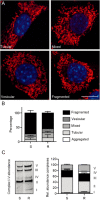Mitochondrial function and energy metabolism in neuronal HT22 cells resistant to oxidative stress
- PMID: 24319993
- PMCID: PMC3976627
- DOI: 10.1111/bph.12549
Mitochondrial function and energy metabolism in neuronal HT22 cells resistant to oxidative stress
Abstract
Background and purpose: The hippocampal cell line HT22 is an excellent model for studying the consequences of endogenous oxidative stress. Extracellular glutamate depletes cellular glutathione by blocking the glutamate/cystine antiporter system xc-. Glutathione depletion induces a well-defined programme of cell death characterized by an increase in reactive oxygen species and mitochondrial dysfunction.
Experimental approach: We compared the mitochondrial shape, the abundance of mitochondrial complexes and the mitochondrial respiration of HT22 cells, selected based on their resistance to glutamate, with those of the glutamate-sensitive parental cell line.
Key results: Glutamate-resistant mitochondria were less fragmented and displayed seemingly contradictory features: mitochondrial calcium and superoxide were increased while high-resolution respirometry suggested a reduction in mitochondrial respiration. This was interpreted as a reverse activity of the ATP synthase under oxidative stress, leading to hydrolysis of ATP to maintain or even elevate the mitochondrial membrane potential, suggesting these cells endure ineffective energy metabolism to protect their membrane potential. Glutamate-resistant cells were also resistant to oligomycin, an inhibitor of the ATP synthase, but sensitive to deoxyglucose, an inhibitor of hexokinases. Exchanging glucose with galactose rendered resistant cells 1000-fold more sensitive to oligomycin. These results, together with a strong increase in cytosolic hexokinase 1 and 2, a reduced lactate production and an increased activity of glucose-6-phosphate dehydrogenase, suggest that glutamate-resistant HT22 cells shuttle most available glucose towards the hexose monophosphate shunt to increase glutathione recovery.
Conclusions and implications: These results indicate that mitochondrial and metabolic adaptations play an important role in the resistance of cells to oxidative stress.
Keywords: cell death; fusion/fission; glycolysis; mitochondria; oxidative phosphorylation; oxidative stress.
© 2013 The British Pharmacological Society.
Figures






Similar articles
-
Neuroprotective Mitochondrial Remodeling by AKAP121/PKA Protects HT22 Cell from Glutamate-Induced Oxidative Stress.Mol Neurobiol. 2019 Aug;56(8):5586-5607. doi: 10.1007/s12035-018-1464-3. Epub 2019 Jan 16. Mol Neurobiol. 2019. PMID: 30652267 Free PMC article.
-
Bcl-xL knockout attenuates mitochondrial respiration and causes oxidative stress that is compensated by pentose phosphate pathway activity.Free Radic Biol Med. 2017 Nov;112:350-359. doi: 10.1016/j.freeradbiomed.2017.08.007. Epub 2017 Aug 12. Free Radic Biol Med. 2017. PMID: 28807815
-
Geissoschizine methyl ether protects oxidative stress-mediated cytotoxicity in neurons through the 'Neuronal Warburg Effect'.J Ethnopharmacol. 2016 Jul 1;187:249-58. doi: 10.1016/j.jep.2016.04.034. Epub 2016 Apr 22. J Ethnopharmacol. 2016. PMID: 27114061 Free PMC article.
-
Glutamate excitotoxicity and Ca2+-regulation of respiration: Role of the Ca2+ activated mitochondrial transporters (CaMCs).Biochim Biophys Acta. 2016 Aug;1857(8):1158-1166. doi: 10.1016/j.bbabio.2016.04.003. Epub 2016 Apr 7. Biochim Biophys Acta. 2016. PMID: 27060251 Review.
-
Mitochondria and diabetes. Genetic, biochemical, and clinical implications of the cellular energy circuit.Diabetes. 1996 Feb;45(2):113-26. doi: 10.2337/diab.45.2.113. Diabetes. 1996. PMID: 8549853 Review.
Cited by
-
New Probucol Analogues Inhibit Ferroptosis, Improve Mitochondrial Parameters, and Induce Glutathione Peroxidase in HT22 Cells.Mol Neurobiol. 2020 Aug;57(8):3273-3290. doi: 10.1007/s12035-020-01956-9. Epub 2020 Jun 8. Mol Neurobiol. 2020. PMID: 32514861
-
The role of the SIRT1-BMAL1 pathway in regulating oxidative stress in the early development of ischaemic stroke.Sci Rep. 2024 Jan 20;14(1):1773. doi: 10.1038/s41598-024-52120-5. Sci Rep. 2024. PMID: 38245621 Free PMC article.
-
Neuroprotective Mitochondrial Remodeling by AKAP121/PKA Protects HT22 Cell from Glutamate-Induced Oxidative Stress.Mol Neurobiol. 2019 Aug;56(8):5586-5607. doi: 10.1007/s12035-018-1464-3. Epub 2019 Jan 16. Mol Neurobiol. 2019. PMID: 30652267 Free PMC article.
-
Protein kinase CK2 contributes to placental development: physiological and pathological implications.J Mol Med (Berl). 2020 Jan;98(1):123-133. doi: 10.1007/s00109-019-01855-0. Epub 2019 Dec 12. J Mol Med (Berl). 2020. PMID: 31832700
-
Mitochondrial pharmacology: energy, injury and beyond.Br J Pharmacol. 2014 Apr;171(8):1795-7. doi: 10.1111/bph.12679. Br J Pharmacol. 2014. PMID: 24684388 Free PMC article.
References
-
- Albrecht P, Lewerenz J, Dittmer S, Noack R, Maher P, Methner A. Mechanisms of oxidative glutamate toxicity: the glutamate/cystine antiporter system xc− as a neuroprotective drug target. CNS Neurol Disord Drug Targets. 2010;9:373–382. - PubMed
-
- Ben-Yoseph O, Boxer PA, Ross BD. Assessment of the role of the glutathione and pentose phosphate pathways in the protection of primary cerebrocortical cultures from oxidative stress. J Neurochem. 1996;66:2329–2337. - PubMed
Publication types
MeSH terms
Substances
LinkOut - more resources
Full Text Sources
Other Literature Sources

